 “Letters To Father Jacob“: Finnish Oscar entry Klaus Haro’s radiant “Letters To Father Jacob” an elegantly simple three person drama, is a jewel of a film. I had an opportunity to interview Haro at The Scandinavian Film Festival LA.
“Letters To Father Jacob“: Finnish Oscar entry Klaus Haro’s radiant “Letters To Father Jacob” an elegantly simple three person drama, is a jewel of a film. I had an opportunity to interview Haro at The Scandinavian Film Festival LA.
Director-writer Klaus Haro (“Mother of Mine“, “Elina: As if I Didn’t Exist” -both Crystal Bear recipients, Berlin; “The New Man.”) was awarded the Ingmar Bergman Award in 2004, an award chosen by Bergman himself.
Haro extensively rewrote the screenplay by first time scripter/ social worker Jaana Makkonen. Makkonen’s scriptwriting teacher encouraged her to send her diploma film to Haro, who only read it when he was home with the flu and too tired to work on his own script. In our interview, Haro described removing as much as he could, winnowing the film down to its purest form. He dropped a b-story with the sister, and locations at the prison, the hospital, and in town, to distill the film into its timeless fabular perfection.
Haro is a sensitive director, capable of getting wrenching performances from his actors, built of tiny nuances and supported with telling visual details. The ensemble work in “Mother Mine” was impressive. “Letters to Father Jacob” is equally compelling.
I asked him about working with his actors. ” I’m so surprised that I do get a lot of praise. I feel like I’m a beginner with actors.” In film school, the mechanical cinematic side came easy for Haro, who is dedicated 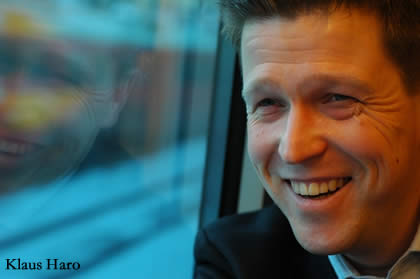 to telling a story in images, but he was afraid of actors. Haro casts actors who have moved him in other films, gives them guidelines, usually about rhythm, then allows them to discover. ” Actors are usually the most skilled people, know more about storytelling than I do.”
to telling a story in images, but he was afraid of actors. Haro casts actors who have moved him in other films, gives them guidelines, usually about rhythm, then allows them to discover. ” Actors are usually the most skilled people, know more about storytelling than I do.”
He uses the rehearsal time to work his way through the script, making changes so that the actors are comfortable, substituting behavior for dialogue whenever possible. Some of his greatest scenes in both “Mother Mine” and “Letters To Father Jacob” occurred when he let the camera run after an especially emotional moment.
Haro, who keeps a mental shortlist of actors he wants to work with, assembled is dream cast. Haro worked with Heikki Nousiainen in his first student film in 1996. “To my mind he’s the greatest Finnish actor alive”. He offered the busy stage actor parts before, but the recently retired Nousiainen was finally available for to play Father Jacob, his first leading role in films. Kaija Pakarinen, who plays Leila, is a journalist and part time actress, who Hano remembered from a television show ten years ago. “She made the seasoned actors look phony.” Jukka Keinonen who plays the bicycling postman, is a comic actor and lends a Tati-like whimsy to the piece.
Discussing the changes in the script Haro explained.” We made Father Jacob a little less holy, less a saint. We gave him a frailty. In the beginning he was a man with a mission, then we stripped him of that.” With Leila, who needed her own space, Haro was worried the audience would think it was about sexual harassment. He made it more ambiguous.
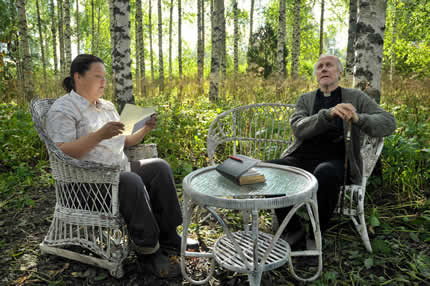 His luminous shots of nature (narrative rather than decorative) are matched by his shots of the human face, in which every thought and passing feeling is carefully recorded. Haro uses long shots and a slow moving pan, but our attention never wavers in the perfect 72-minute meditation on the nature of love, faith and the human heart.
His luminous shots of nature (narrative rather than decorative) are matched by his shots of the human face, in which every thought and passing feeling is carefully recorded. Haro uses long shots and a slow moving pan, but our attention never wavers in the perfect 72-minute meditation on the nature of love, faith and the human heart.
Like a haiku poem or a wind ruffled chime, the delicate truths of this film ring in the mind, and bear repeating. A naturalist soundtrack is amplified by Dani Stromback’s sparse supple piano score. ( Original music plus Chopin, Offenbach, Beethoven.) Raindrops on letters, wind in the weeds, and a whistling teapot are part of the score’s instrumentation.
Prison hardened murderer Leila Sten has served 12 years of a life sentence when she is suddenly pardoned. Sullen Leila who’s refused all contact with her sister has nowhere to go. The warden suggests a job as Mr. Jacob Ljube’s personal assistant. “It starts immediately, it’s as quiet place, easy, a roof over your head.”
Our introduction to the dilapidated rural parsonage is a close up of a whistling teapot. (It figures as a character.) Husky Leila enters the darkened house. A unique deep focus shot reveals the entry way, panning it reveals the circular floor plan of the home, and slumped in a corner at the apex of the shot, the sleeping Father Jacob.
Leila wanders the darkened house, stopping in a doorway just short of Jacob’s seat. Father Jacob wakes and extends his hand, but wary Leila ignores his eager greeting. He offers her tea. She wants coffee. Watching him prepare her tea in the dark, she waves a sharp knife in his face, to check if he’s blind.
“I don’t do house work” mutters Leila, only to discover she’s become the compassionate priest’s secretary; answering the daily letters he receives from people asking for his prayers. No request is too trivial. For Leila, who’s survived in prison, all this god stuff seems laughable, as her expressions make clear.
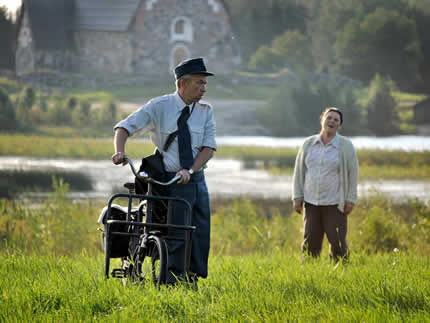 “We have quite a bit to do here” announces the expectant Father Jacob. Hearing the Postman’s bike bell, Jacob lights up, a little smile plays at the corner of his mouth. “And here comes some more.” Jacob rushes outside to get the mail. “You’ve got a new bike’ he remarks, noticing the different sound it makes. ‘Leila and I were having tea.” “Leila, the lifer?” asks the worried postman. He’s right to be worried, Leila outweighs him
“We have quite a bit to do here” announces the expectant Father Jacob. Hearing the Postman’s bike bell, Jacob lights up, a little smile plays at the corner of his mouth. “And here comes some more.” Jacob rushes outside to get the mail. “You’ve got a new bike’ he remarks, noticing the different sound it makes. ‘Leila and I were having tea.” “Leila, the lifer?” asks the worried postman. He’s right to be worried, Leila outweighs him
Jacob’s celestial blue unseeing eyes warm as they sit in the garden to answer the mail. “I wonder what’s burdening their minds today.” Listening hard to a worried grandmother’s letter he cites bible verses then dictates, “With Loving regards, Father Jacob and Leila Sten.” “For Christ’s sake!” Leila snaps. Deflated he signs, “I suppose Father Jacob will do.” Leila’s scornful expressions mock the priest’s good deeds.
Father Jacob tells Leila to put the answered mail under the bed, where letters are stacked from floor to bedsprings. She can barely slide the handful of letters in.
He explains the intercessionary letters. “It’s important that they feel that someone is watching over them, no-one is useless or forgotten, all the letters are valuable. We take them to heart.” “You take them to heart,” she snaps. “…and ask God to a pardon them,” he continues. “It was you,” she realizes. “You requested my pardon.”
“Postia pappi Jaakobille” (Letters for Father Jacob!) rings the cheery call of the postman. The good priest comes alive at the sound. His life has purpose for another day. His unsighted blue eyes fill, his mouth crinkles into a faint smile, he even blushes doing the Lord’s work.
Sitting in the garden they open the letters. Father Jacob recognizes his parishioners from the first sentence. One woman returns his life’s savings, which he loaned her to escape her abusive husband. Aghast at his generosity, survivor Lelia toys with taking his money. But transforming, despite herself, Leila replaces the money.
When the worried postman sees Leila the next day, he backs away. “What have you done to him?” the protective postman asks. Annoyed with her meaningless task, Leila dumps a pack of unanswered letter down a well.
For days the frightened postman steers clear of the house. One afternoon he sneaks into the house to check on Father Jacob. Showing the toughness she needed to survive in prison, Leila stifles him and strong-arms him out of the house, convinced he’s after Jacob’s money. ” I came to see if he was alive.” Why wouldn’t he be?” asks Leila. “Leave the old man alone. Go back where you came from,” he warns. They face off like two siblings, competing for the same father figure.
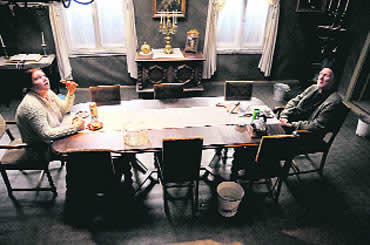 Each day, the wistful Father wonders where the mail is.Rudderless he muses, “You can’t expect to get mail everyday.”
Each day, the wistful Father wonders where the mail is.Rudderless he muses, “You can’t expect to get mail everyday.”
One day, Jacob asks Leila to set the table with the good china. They’re expecting wedding guests. Like a baby duck following its mother, Leila follows the old man, in his frock coat and pajama pants, to an empty church.
He instructs her to stay outside, “Tell me when the guests arrive”. Kneeling, his face full of doubt, Jacob breaks down, unable to pray. When Leila comes back to tell him no-ones coming, the priest who painstakingly memorized his bible verses explains “I thought It was my mission, to pray for people. What was I thinking? I don’t even get letters anymore…I’m not needed anymore.”
Shrunken, defeated Father Jacob asks Leila to help him back to the house. His voice echos like the plaintiff plea of a child. Fed up, Leila refuses, stomping out. Alone in the empty church, Father Jacob strokes the walls, saying goodbye to his religious ‘home’. The vivid soundtrack summons the internal life of the blind, the sound of his hand on the walls, the desolate patter of rain.
Leila packs and calls a cab, but when the cab driver asks her “where to?”, she has no answer. Wandering home, Jacob interrupts her clumsy suicide attempt. “Leila, you’re still here?” he asks amazed. Contrite, she brings him tea and sits with him in his room. Her defensive body language changed, Leila listens like a child. “All these letters, Leila, I thought I was doing all this for Him, but maybe it was the other way around. Maybe it was all for me. Maybe it was His way of holding on to me. Of leading me home.”
Leila’s face transforms, her mouth softens, her heart opens. Blinking repeatedly, a lifetime of defenses washes way. No longer looking away, she meets the camera with lambent eyes, struggling with her returning feelings.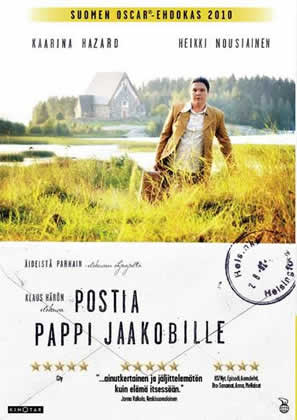
The letters stop coming, and Father Jacob collapses into ill health. Leila and the postman conspire to make letters appear. Forced to improvise the content of imaginary letters all she can come up with is her own abysmal story. Attuned to the human heart, Father Jacob realizes she’s pretending to be kind. But what he hears surprises, him. Leila confesses her crime. It’s the answer to his unspoken prayer. Leila needs his forgiveness.
“My mother use to hit me. When I was a baby. My sister would get between my mother and the crib. Don’t hit the baby, she would shout at my mother. My brave sister.” She shakes her head, remembering. Watching her sister’s husband beat her, she stabbed him. “I wanted something better for my sister and ended up ruining her life. Who can forgive someone like me? “
“Is there a name on it?” ” Yes.” “Leila Sten”, he nods wisely. “What is impossible with men, is possible with God.” Leila looks at him, relieved. “There’s something I want you to see.” She looks up at him, thankful, expectant, as he sloshes through the mud in his bare feet. He hands her stack of letters from her sister, who wrote him through the years, asking him to arrange Leila’s pardon.
‘Take your time, I’ll go make tea for us.” Getting up he staggers. Leila takes his hand, to steady him. It’s the first physical contact they’ve ever had. Taking her hand, he leans down, fondly. “And coffee.” She watches him, concerned. Crying she reads ” can’t stand living not knowing about my sister. She’s my only sister. Without her, I’m all alone. That’s why I’m turning to you.” Forgiven, renewed Leila goes to turn off the whistling teapot and finds Father Jacob, dead, on the floor. Mission completed.
Haro’s very particular about his locations. In “Mother Mine” the Swedish landscape was the foundation of everything. ” The biggest argument I had with the producer was about the locations which were very far from the city.” The church interior, exterior and the parsonage were all in the north or western part of Finland.
He set the story in the 70s; before cell phone and faxes in the quiet Finnish countryside (no longer like that.) “The place should tell a story. I had the idea of a place that looked like its owner, worn out, fading away, a garden where secrets could be revealed. Scandinavian vicarages are long houses. I wanted to shoot in Cinemascope, to show the distance between the people. “
The film was originally shot for television. TV producers hate cinemascope which requires letterboxing. Haro fought the producer and won. After the film was finished, the producer realized how cinematic it was and suggested a short cinema run before it aired. The TV people accused the producer of tricking them into financing a film for cinema release. Working for television, with it’s small financial investment won Haro freedom to proceed without a lot of interference.
We had three weeks of shooting. I could never have made this if it had been my first film. With every film, I try a new set of rules. I wanted simplicity, no gimmicks, tricks, dolly shots. I always asked, can we do this in one shot?”
Humble Haro, who challenges himself to work with a new team on each project, gave credit to his team at every turn. ” Not all choices were made by me. Everybody contributes. The DP, the sound designer Joonas Jyrälä (“Mother Mine”) and the editor (Samu Heikkilä’s) bold edit.” Looking at Heikkilä’s first edit of the opening scene in the prison, with the long close-ups of Leila and the Warden’s face, Haro jettisoned the master shots. “Why did we build this expensive set if we hold on their faces” grumbled his producer.
Equally, Heikkilä’s assembly of the scene in the church (originally conceived as a montage of shots in the church cut to music) surprised and moved Haro. The near silent scene, featuring Nousiainen’s exploration of the deserted church, and Heikkilä’s sensitive edit, form an expressive cinematic passage. “We challenged each other. Dare we be slow and silent and feel every moment? We removed a lot of music. Every sound would have meaning, a world where nothing much happens, a world where he’s guided by sound.”
The composer, Dani Strömbäck (who once toured the states as a gospel pianist) sent them 20 minutes of music after reading the script. Half of the music was done without seeing the film. They edited some of the scenes to his score. He wrote more for the long visual scenes. “His music gave a light flowing feeling to the film, easy to destroy.” D.P. Tuomo Hutri shot the film on the Red digital camera, achieving rich imagery as delicately detailed as 35mm.
Growing up in Porvoo in the eighties, Haro didn’t have a VCR. His friends with VCRs wanted to watch Ninja action flicks, he wanted to watch Ford and Wells. He bought soundtracks to Fellini and Hitchcock, read about movies in books and imagined the films. Memorizing the season program, he waited to see the classics on TV. Sometimes he waited years to see a film, but he knew the soundtrack by heart. That connection with waiting, and music, kept his ideas flowing.
I asked Klaus what films inspired him. He loved the Chinese masters, who use extreme wide shots and extreme character close-ups. In Zhang Yimou’s lesser known “The Road Home “, which he first saw in Berlin in 2000, he cried from the midpoint to the end. “I’m movde by the innocence” Haro explains, mourning earlier, simpler times when people’s words mattered, people mattered: unlike the current period when “everything can be swapped, replaced (marriage family, work), nothing matters.”
‘The best films use very few elements and draw from the human experience, remain to the characters.” Haro loves “Being There”, Hal Ashby’s greatest film, which he waited years to see. “When I see these films I realize they’re the teachers, I’m the pupil.” Haros list of favorites include Chaplin’s films (which he’s showing to his small children), Wilder’s “Ace In the Hole“, Coppola’s “The Conversation”, Bergman’s “Autumn Sonata“. Haro also cited the work of George Stevans, Lumet, Pacula, Bille August and Jan Troell. “Good story tellers with an element of poetry.”
For years he was embarrassed to admit how much he loves “The Sound Of Music.” Watching it again with his kids, he started crying, recognizing camera moves and compositions in all of his films that came from Robert Wise’s story about losing and finding a new family. (Think “Mother Mine.”)
Haro, who became interested in Jewish life, after two visits to Tel Aviv in the 90’s, reads the Jerusalem Post. “The European narrative of Israel is very one sided.” Watching average Israeli debating contentious issues, he saw democracy at work. He’s developing a story about Finnish Jews during World War II. Finland and Germany cooperated during the war. Finnish Jews and German soldiers fought the Russians side by side.
A provisional schul of cardboard and blankets, erected in the forest, stood unmolested throughout the war. The Germans were told to leave it alone. Although they worried, the only Finnish Jews who were exported were eight Jewishrefugees. Haro’s working the seeds of this story into a script
His next picture,” The House Of Hope“, planned with the producer of “Letters To Father Jacob“, tells the story of a young Finnish soldier on the Russian front in 1944, who challenges his hard-bitten, hard-drinking mates to build a house for the widow of one of their fallen buddies, then send it back to Finland.
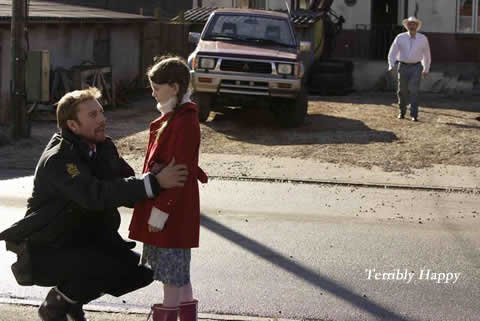 Denmark‘s Foreign Oscar entry, Henrik Ruben Genze’s gallows piece “Terribly Happy” should have made the Foreign Short List, but the Academy’s not fond of dark comedy. Shot like a western (think “Bad Day At Black Rock” with jokes) it’s a witty weave of psychological suspense, horror and noir elements. It reminded me of “Blood Simple” but less self-conscious and with a deliciously wicked sense of humor.
Denmark‘s Foreign Oscar entry, Henrik Ruben Genze’s gallows piece “Terribly Happy” should have made the Foreign Short List, but the Academy’s not fond of dark comedy. Shot like a western (think “Bad Day At Black Rock” with jokes) it’s a witty weave of psychological suspense, horror and noir elements. It reminded me of “Blood Simple” but less self-conscious and with a deliciously wicked sense of humor.
A narrator, as sardonic as one of Hitchcock’s introductions, explains: A cow sunk into the bog, when it reappeared it gave birth to a two-headed calf with a bovine and human head. Local women lost their heads and their unborn babies. The townsmen dropped it back in the bog. Since then they had no more problems with cows or women.
When Stockholm cop Robert Hansen (Jakob Cedergren) discovered his wife in bed with a colleague, he pulled his gun on the adulterous couple. Exiled from the family home, he’s shipped off to a small town to cool his heels. Dropping him off, his superior describes the town as a place where nothing much happens, but from the minute the new lawman arrives, we sense something’s very rotten in Denmark.
Nobody in this town of a many secrets wants a lawman. “That’s not the way we do things”. They take matters in their own hands. There’s a local word for hello and goodbye “mojn”, even the cat is heard to say it. Goodbye is the operative word, since anyone who tries to change the way things works, conveniently disappears.
Mild-mannered sawbones Dr. Zerleng (Lars Brygmann) welcomes Hanson to town, trying to enlist him as a fourth for the local card game.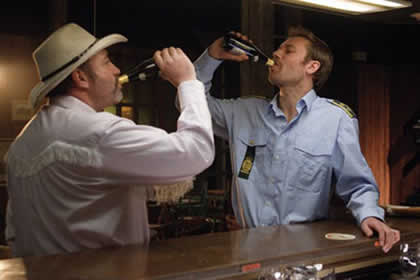
Within minutes, Ingerlise (Lene Maria Christensen, a noirish off-kilter, dame in distress appears in his office.
Her husband, town bully Jørgen Buhl (Kim Bodnia), batters her regularly. Whenever their young daughter Dorthe (Mathilde Maack) wheels her squeaky empty doll carriage down the street, the town knows that Jorgen’s pounding poor Ingerlise.
Most recently Jørgen grew jealous of the new (now missing) bike dealer. Everybody knows about Jørgen’s deadly temper, but nobody crosses him. The overweight goombah, slouching under his 10-gallon hat, a cigarette pinched in his lips, starts watching Hanson.
Ingerlise makes a move on any new man in town, looking for her savior. Even Dr. Zerleng played white knight, till he learned better.
Zerleng, who refers to himself as the town quack, supplies Ingerlise with industrial strength painkillers. He treats broken bones of Jørgen’s victims, but he doesn’t dare report him.
Dr. Zerleng, shopkeeper Købmand Moos (Anders Hove), priest (Henrik Likkegaard) sit around all day boozing and playing cards. They expect Hanson to make up the fourth, like his predecessor, but tee totaling, by the books Robert isn’t interested. At first he tries to mete out liberal big-city justice. The most urgent crime call is preschool shoplifters. Moos traps the young Knud in a closet. Letting the young miscreant go earns the shopkeeper’s contempt. He expects Hanson to slap the kid around, as Jorgen demonstrates.
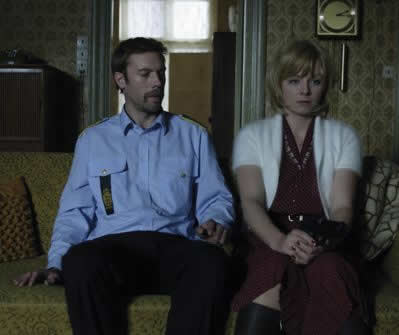 Hanson tries to investigate the missing bicycle salesman. The omnipresent townsfolk never tire of watching him and telling him what to do. Ingerlise chides him for his badly hung laundry. “That’s not the way we do things”. Hanson starts to implode. His wife won’t let him speak to his daughter in Stockholm. He flushes his meds down the toilet and starts hearing things. He goes off the wagon and chugs beers. (There’s a brilliant showdown in the bar as Hanson and Jørgen drink themselves insensible.)
Hanson tries to investigate the missing bicycle salesman. The omnipresent townsfolk never tire of watching him and telling him what to do. Ingerlise chides him for his badly hung laundry. “That’s not the way we do things”. Hanson starts to implode. His wife won’t let him speak to his daughter in Stockholm. He flushes his meds down the toilet and starts hearing things. He goes off the wagon and chugs beers. (There’s a brilliant showdown in the bar as Hanson and Jørgen drink themselves insensible.)
Bit by bit Hanson accepts their insular toxic ways, in this clever satire of the dangers of conformity. Hanson’s issues are eerily reproduced by the Buehl melodrama (a jealous battering husband, philandering wife, even an estranged little girl.)
Genz and Dunja Gry Jensen’s dry, low-key script never lets up. Each event triggers an unexpected outcome. A one-night indiscretion turns fatal and Hanson’s stuck hiding his tracks. Rescuing Jurgen from frontier justice, he ends up doing him in. When the big city cops come around, Hanson’s superior hides his own guilty secret, as does the guilty pill-pushing quack. The omniscient gossips bide their time, letting Hanson take the fall for their problems. Protecting Hanson, they now own him.
Ganz creates a twisted world, just a little off from our own. Atmospheric lighting, wide-angle lenses and extreme hallucinatory close-ups, a sepia and bruise blue palette, a chilling ambient sound design (leavened with Western clichés) all give the sudden violence a tart bite. Jorgen Johansson’s 2.35:1 anamorphic; images, Kasper Leick’s sharp editing and Kare Bjerko’s amusing score ratchet up the tension. One of the most entertaining films of 2009.

